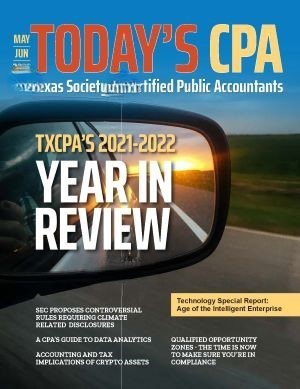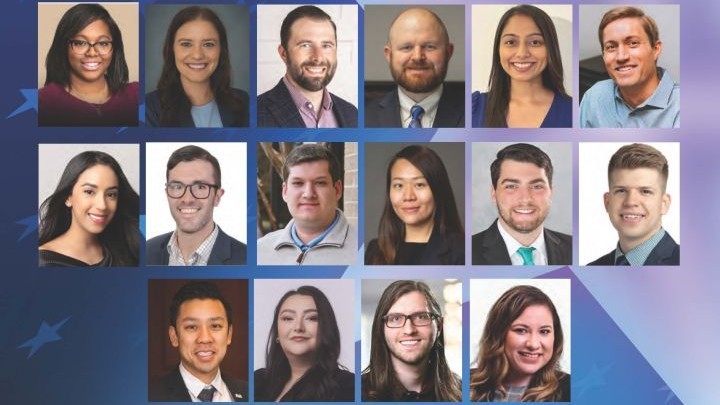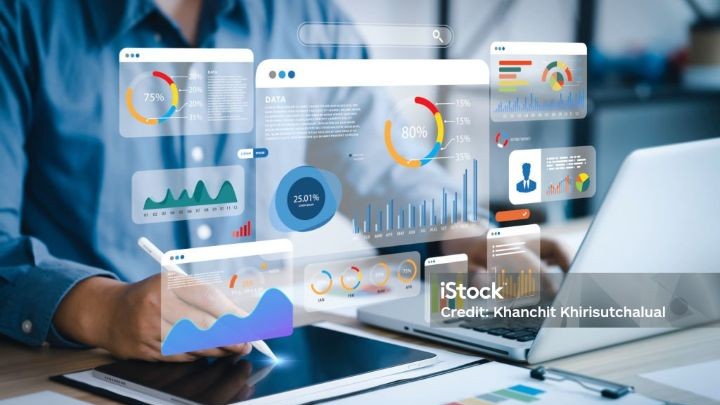Special Report - Technology
It is anticipated that business evolution will lead to intelligent organizations as the exponential increase in data will require organizations to quickly process information to provide better service, faster innovation and improved cost efficiencies. What information will CPAs in both public practice and industry need to prepare for the age of intelligent enterprises or as some have called it, Industry 4.0? The answer is intelligent enterprise.
This special report supported by Dell
The Accounting Profession in the Age of the Intelligent Enterprise
By Izhar Haq, Ibrahim Siraj, Syed Osman, Michael Abatemarco
It seems that every day, the word smart is being added to common objects. First there was the smart phone, then there were discussions on the future of smart cars and smart homes. The basic idea is that “smart” makes the device capable of doing things beyond the basic function.
Early “non-smart” phones had only one function, which was to make or receive phone calls. Smart phones allow the phone to be used as a web browser, email device, camera, video camera, video conference device, alarm clock, and so much more. In a like manner, businesses are expected to evolve as smart devices and technology permeate throughout the organization.
It is anticipated that business evolution will lead to intelligent organizations as the exponential increase in data will require organizations to quickly process information to provide better service, faster innovation and improved cost efficiencies. The purpose of this article is to provide CPAs in both public practice and industry the information needed to prepare for the age of intelligent enterprises or as some have called it, Industry 4.0.
What is an Intelligent Enterprise?
The phrase “intelligent enterprise” is credited to James Brian Quinn,1 who published a book “Intelligent Enterprise” in 1992, in which he articulates that intellect is the key resource of any business and that further routinizing internal processes will give way to reorganizing business operations to create greater perceived value for the customer.2 Kevin Poskitt, who is responsible for leading SAP’s next-generation projects in unified ML, wrote that “Intelligent enterprise is the concept that work should be as seamless, if not more seamless, than the way we live.”3
Intelligent enterprise utilizes tools of artificial cognitive technologies, such as machine learning (ML), natural language processing (NLP), artificial intelligence (AI) and other algorithm-based techniques of data analytics to create an integrative system of information. The system uses the cloud platform that makes it efficient and easier than ever before to crunch big and complicated data, which can be shared instantly at any time at any place.
Since AI can scan and extract necessary information from digital documents, it can easily complete the initial screening of financial records and identify any unusual patterns or trends that require human judgment. Furthermore, the system of ML can lend support to the whole process by continuously updating knowledge of financial transactions. Essentially, ML is the tool that makes the whole AI system more efficient and capable of undertaking optimal decisions.
To understand what all this means is to first realize how a typical business user interacts with the data of their business. Sales data is typically in a sales system; financial data is in a financial system; consolidation is typically done in a separate system; forecasting and planning is still another system; and so on.
Enterprise Resource Planning (ERP) systems typically attempt to bring a number of those activities into one integrated system. However, even ERP systems can be a challenge for users to obtain the information they need in a format that they can use to make decisions.
In an intelligent enterprise, not only will the data silos disappear, but also organizational silos will disappear. Rather than solving finance problems, manufacturing problems, logistical problems, etc., the focus will be on seeing every problem as a company problem and the solution will be based on an integrated problem-solving approach.
Two particular forces are driving the change within businesses. One is the technological innovations of computer storage and power that are enabling big data and ML. The other is the growing body of research in human decision-making and judgment.4 The idea behind the intelligent enterprise is to create a work environment similar to what individuals experience online in their personal lives where whether they are ordering merchandise, watching a movie, listening to music or using social media, their connection is immediate and seamless in their lives.
Difference Between AI and ML
For the purpose of this article, it is important to distinguish between AI and ML. AI and ML are often used interchangeably, but they shouldn’t mean the same thing. To put it in a light note, AI is basically machines thinking like human beings, trying to simulate human intelligence and coherence. Just as in the case of a typical human being, it takes time for the brain to mature and be able to make rational decisions; the same applies for AI. Just like we cannot expect rational decision making from a toddler and have to support and teach him/her in every step until he/she becomes mature, the same holds for AI.
It also takes time for AI to perform optimally and by time, we mean data history and heterogenous data environments. Only if we can feed an AI structure or an AI algorithm enough data and scenarios can it perform in an “intelligent” way.
ML is basically computers learning from the data environment they’re exposed to on a particular aspect and building/improving on that learning every time they’re exposed to new data and history. There is a lot of human intervention (fine tuning the ML model parameters and algorithm) involved in this learning process.
On the other hand, AI would mean zero actual human intervention. So, ML is a subset of AI. In other words, ML is the way to get to AI. The path of convergence from ML to AI is a concave one (imagine AI as a peak of a hill). Initially, the convergence rate is high, but the rate continues to go down as we move closer to that peak. That said, the invention of quantum computing and its potential use can fundamentally speed up the convergence rate.
Why Intelligent Enterprise is the Next Evolution for Business
Avande, a Seattle-based consulting company specializing in AI and workforce transformation, described the evolution of business best in their document The Intelligent Enterprise: It’s the Way to Predict and Lead in Your Market, in which they stated: “Industrial revolutions have come along every 100 years over the past few centuries – think mechanization and steam power in the late 1700s, mass production in the late 1800s and computers in the late 1900s. And now, just half a century after the start of the electronic era, we have the fourth industrial revolution, the Era of Intelligence. It blends global networks, the internet of things, machine learning, predictive analytics and more.”
Business success in large part depends on creating and sustaining a competitive advantage. That competitive advantage can be based on economies of scale, proprietary technology, artistic talents or visionary leadership. However, in the knowledge economy, shared ability to make superior decisions based on available information will be the key to sustaining a competitive advantage.3
The key to this type of competitive advantage will be to combine human judgement, ML and big data.
Accenture, which provides technology and business consulting, surveyed over 5,400 business and information technology executives and found that 86% of the respondents indicated that while individual technologies are rapidly advancing, it is the multiplier effect of these technologies that is creating innovation breakthroughs.5 That same study also found that 74% of the executives surveyed indicated that their organizations are entering new markets that have not yet been completely defined.
An integrative system of intelligence can:
- Efficiently handle the challenging tasks of coordination among the various departments in a company and optimally align the interests of the stakeholders;
- Provide useful predictions;
- Automate repetitive tasks;
- Extract information from both structured and unstructured data; and
- Create a systematic digital repository of information and digital intelligence, etc.
Digitalist magazine highlighted the rationale for businesses to evolve into intelligent enterprises in an article in which they stated “As technologies become increasingly intelligent, businesses are continuing their evolution in using technology to shape the way work is done and maximizing its impact on business performance and value across the enterprise."6
This drive toward maintaining a competitive advantage and exploiting new opportunities is forcing businesses to integrate the new technologies into their operations in order for them to be more agile in a changing business environment.
A Case Study on the Evolution of the Intelligent Enterprise: Adidas When it comes to preparing for the changes, it is really about how to systematically process the enormous amount of data that are generated on a daily basis and how actionable insights can be extracted from these huge data. Adidas, a company known for its sports shoes, is a case study on the evolution of the intelligent enterprise. Adidas’ business model relies on research conducted by sales and marketing to drive new product development.
By embracing intelligent enterprise and data rich information on customers, along with ML and predictive analytics, Adidas is eliminating unneccassary inventory, streamlining production and reducing the new product development cycle. Every process is connected by ML to ensure continuous improvement. Business decision making is not only faster, but more targeted to ensure issues are addressed before they become significant problems.7
Accounting and Finance Functions
Accounting and finance functions within businesses have been evolving as computers have become commonplace in the work environment. Tasks that were completely manual were automated so that less staff was required per transaction.
Accounts payable has reached a point where:
- Invoices are received electronically and matched with the purchase order within the system;
- Confirmation of receipt is done online; and
- Payment is processed electronically with the bank.
As more of the transactional processes are managed by ML algorithms, the finance and accounting functions will focus fewer resources on the back office and more resources on “proactive, forward looking, predictive functions powered by intelligent insights.”8
This shift from labor-intensive transaction processing to forward-looking predictive functions will require a deeper understanding of financial processes to ensure that financial processes are in compliance with policies and regulations. How is this done? It's done by standardizing core services provided to the business (order-to-cash, procure-to-pay and so on), and by leveraging technology and automation to ensure financial excellence while freeing up critical finance resources to focus on strategic initiatives.9
Cloud computing enables firms to update the information of business activities of different departments within a firm, including financial transactions, and share it instantly. For example, the tedious process involved in receiving and completing supply orders can be done more efficiently and transparently with the use of cloud platforms shared with responsible authorities.
Furthermore, in coming years, companies are expected to use blockchain technology to keep the digital records of inventories and complete purchase orders. In fact, as an example, Moong, an aircraft component maker, keeps a system of blockchain-based ledger account, which helps them to instantly receive and compete orders.10 NLP can also be a very useful tool to deal with a large portion of unstructured and textual data.
Auditing in the Age of the Intelligent Enterprise
The greater that companies or organizations rely on technology to automate business processes, the more important it is for audit firms to use technology to audit those companies or organizations. In fact, current audit standards encourage the use of technology and technology specialists by audit firms.11
The audit function has changed dramatically in the last 20 years through the use of basic productivity and audit management software. As enterprises have become more intelligent in their business processes, the greater the need has becomes to intelligently automate the entire process.
In fact, the survey The 2015 Deep Shift: Technology Tipping Points and Societal Impact, done on 816 executives from the information technology and communication sector, reveals that 75% of respondents projected that AI would conduct 30% of corporate audits by 2025.
One of the most critical areas in audits is risk assessment. The ability of audit firms to effectively assess risk will depend increasingly on their ability to process large amounts of digital data. This will take audits to the realm of ML and data analytics. As companies become more intelligent, audits need to become more intelligent, as well. Risk assessment is also an area that will become a critical responsibility for the internal audit departments of companies.
A critical aspect of auditing involves extracting information from a comprehensive set of structured and unstructured data that can ultimately provide useful insight about the financial and non-financial position of a company. A large chunk of such tasks is both systematic and repetitive in nature, which could be efficiently done through AI.
Intelligent enterprises and the evolution of the digital economy will also impact the expectations of key stakeholders in capital markets, including investors and creditors. The demand for information beyond the basic financial statements will also increase, as well as timely information beyond the traditional quarterly results.
The demand for more detailed and timely information will increase the demand for assurance services from public accounting firms. Consequently, the need for a 24/7 auditing protocol becomes apparent if firms intend to compete for scarce resources and ultimately succeed in the current and evolving real-time global economy. 14
The role of the traditional audit that looks back at the prior fiscal results and attempts to determine if the information is fairly presented will become increasingly limited in value because of the accelerating speed in which information is flowing. AICPA supported this thinking when it stated that “… one could argue that the traditional manual and retrospective audit is becoming an untenable position.”14
Significant Changes for the Accounting Profession
It has been said that the first industrial revolution was steam power. The second was mass production and the third was computerization.
Now it is said that the fourth industrial revolution is at hand in which the traditional hierarchal structure that was created during the industrial revolution will be replaced with organizational structures that maximize the intellectual capital that companies have. Intellectual capital will become increasingly important for businesses in terms of improving processes and sustaining competitive advantage.
The evolution of the intelligent enterprise will result in significant changes to the accounting profession. The most significant will be in the areas of auditing and assurance services.
The external audit process will increasingly demand extensive use of data analytics and ML to reduce the time and effort of audits while increasing the accuracy. The demand for assurance services is expected to increase as the demand for more timely information increases from the stakeholders of capital markets.
About the Authors
Izhar Haq, CPA, Ph.D., is an associate professor of accounting at the school of professional accountancy at Long Island University–C.W. Post, Brookville, New York.
Ibrahim Siraj, Ph.D., is Assistant Professor of Accountancy at LIU Post, Brookville, New York.
Syed Osman, Ph.D., is Associate Professor of Data Analytics at LIU Post, Brookville, New York.
Michael Abatemarco, CPA, JD, LLM, is a professor of accounting, law and taxation at the school of professional accountancy at Long Island University–C.W. Post, Brookville, New York.
Footnotes
1 Wikipedia, https://en.wikipedia.org/wiki/Intelligent_enterprise
2 James B. Quinn, “Intelligent Enterprise,” Free Press, 1992
3 Kevin Poskitt, “What is The Intelligent Enterprise and Why Does it Matter,” Digitalist magazine, 2018, https://www.digitalistmag.com/cio-knowledge/2018/05/17/what-is-the-intelligent-enterprise-and-why-does-it-matter-06167321
4 Paul J. H. Schoemaker and Philip E. Tetlock, “Building a More Intelligent Enterprise,” MIT Sloan Management Review, 2017
5 “Accenture: The Era of the Intelligent Enterprise,” Huffington Post, 2017
6 “New Role for the CFO: Navigator to the Intelligent Enterprise,” Digitalist magazine, 2018, https://www.digitalistmag.com/finance/2018/11/15/new-role-for-cfo-navigator-to-intelligent-enterprise-06194089
7 “Data-driven Approach Scores Big with Adidas,” Accenture, https://www.accenture.com/us-en/case-studies/digital/success-adidas-data-driven-experience-design
8 “Transforn finance for the intelligent enterprise,” Technology Consulting, 2019, https://www.accenture.com/us-en/insights/consulting/intelligent-enterprise-finance
9 Tammy Coley, “Rethinking Finance: Creativity and the CFO,” Blackline magazine, 2018
10 “Blockchain, 3-D Printing Combine to Make Aircraft Parts,” The Wall Street Journal, November 26, 2019
11 https/pcaobus.org/Standards/Archived/PreReorgStandards/Pages/Auditing_Standard_3.aspx
12 Feiqi Huang and Miklos Vasarhelyi, “Applying Robotic Process Automation (RPA) in Auditing: A Framework,” International Journal of Accounting Information Systems, December 2019
13 J.L. “John” Alarcon, Troy Fine and Cory Ng, “Accounting AI and Machine Learning: Applications and Challenges,” Pennsylvania CPA Journal, April 2019

















